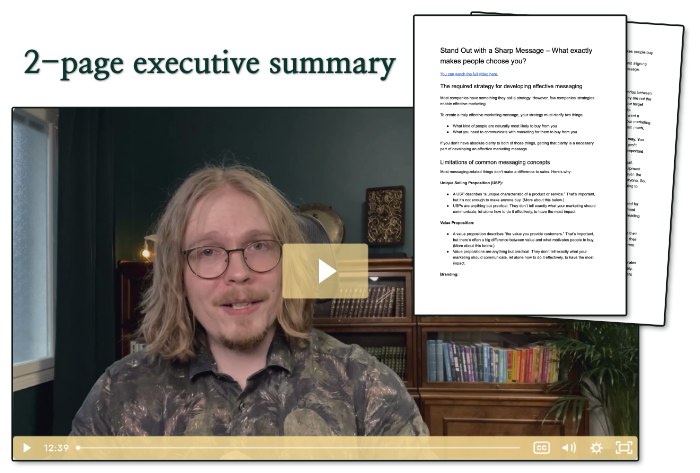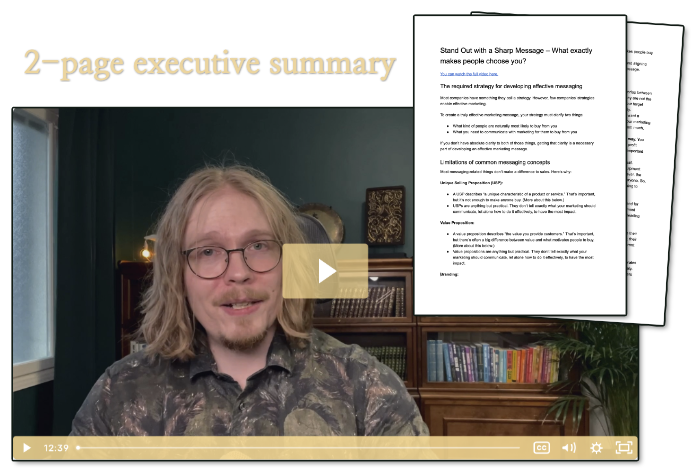If you’ve decided to do advertising, the next step is to find the right advertising methods. There are lots of options—and most of them are bad for your business.
Even if you do everything right, making a profit with advertising has its challenges. Using the wrong methods makes it almost impossible.
That said, advertising is one of the three methods for getting traffic and high-quality leads that I recommend to most of my clients. If you’re serious about your business, you should use advertising. You just need to be smart about it.
So, let’s look at the options you should pick from. And let’s go through how to narrow down the list to the options that are most likely to work for you.
This is part 3 of the “How to get traffic and high-quality leads efficiently—3 most consistent methods for 99% of companies” series.
Part 1: Traffic is a vanity metric—here’s what pros track instead
Part 2: How to be smart about advertising and make a consistent profit
Part 3: How to choose the right advertising methods for your business
Part 4: How to write a guest post that attracts leads
Part 5: Partnership marketing methods—examples for all businesses
The criteria an advertising method needs to meet
The advertising method you choose should meet these criteria. It might all seem obvious to you. But still 90% of people don’t think through these things before they start advertising.
- What advertisements would your target customers see? Trying to reach stay-at-home moms with Linkedin ads might be tough.
- When can they take the action you’re asking them to take? For example, a radio ad that plays during rush hour is likely to reach people when they’re driving. If you ask them to visit your website, it’s difficult, even if they want to do it. AdWords is the other extreme. You reach people when they’re looking for a way to take the action you’re offering them (at least if you do it right).
- Where do they want to see information related to your offer? Even if people could take the action you’re asking for doesn’t mean they want to do it. For example, Facebook is entertainment for many people. Advertising something they see as stressful is harder than promoting something fun.
- Which options fit your brand? Most options fit most brands just fine. But if you sell luxury clothing, don’t advertise on trash cans or the backs of bus seats.
- Which options can you afford to try? Some advertising methods are quick and cheap to try. Others not so much. For example, television and movie ads take quite a bit of money to try out (likely at least a few thousand).
- Which options do you have the expertise for? If you don’t know how to use a specific method, are you going to get expert help? Some options are easier to figure out (e.g., Facebook ads) than others (e.g., direct mail). But investing into something without knowing how to do it is risky. So, if you have options you understand better, avoid the additional risk.
Online advertising methods
Note about PPC advertising:
You pay for most online advertising based on clicks. Or that’s what they say. The idea is that you only pay when someone clicks your ads. It’s true—if no one ever clicks your ads, you don’t pay. And the invoice will point out the number of clicks you’re paying for. But it’s misleading.
For example, 5,000 people see your ad on Google and 5 people click it. You’ll pay more per click than if 100 people had clicked the ad.
If Google shows an ad that 2% of people click, it makes more money than if it shows an ad that only 0.1% click. In other words, showing an ad has an opportunity cost for Google. And the only way it can justify showing the lower-converting ads is by charging more for those clicks.
So, you think of pay per click (PPC) ads as something between PPC and pay per view advertising methods. Don’t just look at the number of clicks—do your best to improve click-through-rates, too.
Facebook Ads
Facebook has been the most hyped up advertising platform for a while. Most companies can get fairly cheap and well-qualified traffic from Facebook. If you’re thinking of trying advertising, it’s likely a good first option to try out. Although, you should think through all the options. Facebook isn’t always the best or even a good option.
As for what kinds of ads work best, remember that Facebook is entertainment for most people. You can try to be entertaining, too. But then your ads are compared to whatever each individual finds most entertaining. Facebook is good at finding what people want to see, so the bar for entertainment is high. It’s also why Facebook is so good at reinforcing people’s beliefs—no matter how inaccurate they might be.
The alternative is to focus on the benefits they can get from you—as in most marketing. And many of the most effective Facebook ads are benefit/fact driven. A hint of entertainment can help those ads perform even better.
Both video and text formats can work well. Just stick to newsfeed ads and driving people to your landing pages. There are other viable options, but that’s what you should try first to get some initial results. You can try alternatives later and compare them to those results.
Linkedin ads
Linkedin ads—supposedly—lead to higher conversion rates than other ads. That’s true in some cases. But often, even when it is true, the click prices make Linkedin ads lose to other options. If you can find your target customers from Linkedin, trying their ads makes sense. But try some other options, too, so you see how they compare.
The best Linkedin ads focus on strong benefits. I don’t use Linkedin ads enough to know if the trend has changed. But I’d be surprised if benefit-focused headlines weren’t still the most consistent option.
Other social media ads
Most social media sites offer advertising options. As long as your target customers use the social media, you can test it out. I wouldn’t expect amazing results, but they can be worth testing.
AdWords
AdWords’ cost per click are often high. But if you do things right, the conversions can be remarkable. AdWords is in some ways the most skill-intensive online option. If you don’t know all the tricks and use the best strategy, you’re likely to waste your money.
I usually recommend hiring an expert to handle AdWords for you. To be clear, I mean an expert—not someone who just calls themselves an expert. It’s hard to find the former. Your spam box (and the Internet) is filled with the latter.
The basic guideline to AdWords is to reflect the search term. There’s a lot more you need to get right. But the most important part is to use a headline that’s as close to the search term as possible. If you just get that right, you have a decent chance to get clicks.
YouTube ads
People are still figuring out how to do this. Those who have figured out something that works for them get good results. Others—the vast majority—lose their money (which, to be fair, is the norm with all advertising).
I haven’t used YouTube ads enough to know how predictably you can make them profitable or what’s the most consistent approach. So, at the moment, I’m hesitant to recommend them to my clients. Getting results without high-quality video is unusual, so the bar for entry is quite high.
Banner ads
In short, don’t use them. There are rare cases where they still work well. And if you make a good profit with other ads, trying banner ads as a way to increase ad spend makes sense. If your problem is that you need to look for new ways to increase ad spend, congratulations. For most people, that’s a distant dream.
Native advertising
This is the digital version of advertorials (article-like advertisements in magazines). When done well, native ads can be extremely effective. And since they’re still quite new, the prices are often absurdly low.
The only downside is that it takes some expertise to write these ads well enough. But for the most part, they work the same way as paid guest posts (below). I might write more about native ads when I’ve had time to test them enough to have clear guidelines to share.
Paid guest posts
This is actually a fairly simple way to get good results. That said, very few people do it right. We’ll look at guest blogging in the next part of this series—and the same ideas apply to paid guest blogging. However, there’s rarely a good reason to pay for guest posts. The sites that ask you to pay for them to publish your content are rarely the sites you should write for anyway.
Offline advertising methods
In general, the less an advertising method is used, the lower the prices get. So, some offline options are cheaper than before without being any less effective. The opposite happens with most online advertising methods. Don’t forget offline advertising just because it isn’t a hot topic.
Direct mail ads
If you know what you’re doing, you can almost certainly make a profit with direct mail ads. But if you aren’t a great copywriter, it’s better to stick to other advertising methods (or hire a pro).
There are, of course, situations where direct mail isn’t a great option. But people have sold everything from pears to music lessons with direct mail ads. It works with complex B2B-software solutions and luxury cars, too. So, if you have trouble with direct mail ads, you need better copy.
Magazine ads
Magazine ads can generate great returns on the investment. As usual, targeting is incredibly important. The reason most companies struggle with newspaper ads is the lack of a targeted audience. But if a majority (or at least a significant portion) of the readers are your target customers, it’s worth a try.
Niche magazines (association journals, hobby-specific magazines, etc.) are typically more cost-effective. Targeting is built into them, so a much larger portion of the readers are your target customers.
As for ad content, advertorials work well (article-like ads), but they take a lot of expertise to write well. More common styles of magazine ads can all work as long as you choose the right one for your situation. There are no simple guidelines to follow there.
Television ads
I wrote an article about “how television ads a waste of money” years ago. Simply put, in most cases the costs are too high for it to be profitable. That said, there are exceptions. If your product has very wide appeal, you can consider TV ads. Unusually high profits per sale can compensate for a lack of universal appeal. I don’t have much experience of using television ads, so I won’t try to go into the strategy.
Radio ads
When done well, radio ads can generate great results. And there are some very interesting, unexpected ways to use them. For example, one of my business friends used to run a large company’s marketing and sales. They used radio ads to sell webinar registrations (which led to high-end service sales).
I haven’t used radio ads nearly enough to feel comfortable making recommendations. The one thing I want to point out is that it’s notoriously difficult to track results from radio ads. So, if you end up using them, make sure you have a way to track the results.
Movie theater ads
Ads at movies are like television ads on steroids. Most importantly, there’s much less of an issue with minimal attention. People typically don’t run to the bathroom during the ads at the movies.
But movie ads aren’t a great option for most companies. Targeting is too vague for most companies. The quality-requirements are high. And costs can get high. Also, since most people can’t or won’t take action immediately, it makes things even harder.
All that said, I’ve recommended movie ads and seen good returns. As for guidelines, it’s a case-by-case kind of strategy. Most of the same rules apply to movie ads and direct mail ads. But that’s still a lot of rules.
Billboards and other kinds of ads outside
They can work. But the costs are usually far too high if your product or service doesn’t appeal to a very wide audience. If you run a local business and you get a good deal for ads near your location, it’s worth considering. When you just try them out, a fairly safe option is a discount offer (or other similar time-limited offer).
Branded gifts and general business gifts
Business gifts can generate massive profits. They’re also the best example of how important targeting is in advertising. Get it right, and you can get the highest returns of any type of advertising. Get it wrong, and you’re guaranteed to lose all the money you spend.
Most business gifts are cheap. The idea is to give them to anyone who’s willing to take one. The problem is that cheap gifts are almost meaningless. And most people already have the cheap things they need. For example, I have a mouse pad I like—I don’t want another.
The alternative is to get unique, more valuable gifts for carefully selected people. These would be people who could help your business significantly. For example, you find 20 people you think would be great partners or affiliates and spend $10,000 on nice gifts. If it leads to one good partnership, you might make a massive profit.
The trouble is figuring out what they would appreciate. The easiest way to do it is to find someone close to them who can tell you what they’d like. You can check if you find their family members from Facebook. Or you can contact their employees (or close colleagues) to get ideas.
The standard option, of course, is a nice bottle of wine. But it’s too much of a cliché to be very impactful. Of course, you could buy a bottle of Domaine de la Romanee-Conti Montrachet Grand Cru—that’s not a cliché. But then you have to hope the recipient likes white wine and knows how expensive it is. If they don’t, they might rather be holding their favorite beer than the $15,000 bottle of wine.
Advertising methods that work online and offline
None of these are strictly advertising. But they’re close enough to be worth mentioning. The way you decide if they’re good for you is also the same as how you choose between advertising options.
Paid endorsements
These can work really well in the right situations. There are (roughly put) two types of paid endorsements:
- Usually you pay someone to give a testimonial you can use in your marketing. It can definitely work, but I don’t recommend it often.
- The alternative is paying people who have their own audience to mention your offer.
The latter option can work for most businesses. For example, check if any YouTube stars have lots of your target customers in their audience. Paying them to show off your product or trying your service can be very profitable.
Sometimes all you need to do is send them your product, and they’ll mention the gift they got. However, for that to work, you really need to know the person you’re approaching. If they never mention products or services in their content, they won’t mention yours either. But if they often talk about things they get and like, it’s usually a low-risk—high-reward thing to try.
For example, if you sell unicorn slippers, send a box of them to Lilly Singh (YouTube comedian). I’d be amazed if she didn’t talk about them in her vlogs. But if you send her a box of beef jerky, you won’t get far.
So, get to know the people you’re approaching regardless of are you going to pay them or not.
Product placements
Product placements are like the more complex version of paid endorsements. If you get it right, it very well might pay off (Ashton Martin has likely made a lot of sales thanks to James Bond movies).
If a great opportunity comes up, you should consider it. But making a profit with product placements is tricky. The prices of major placements are incredibly high. And most importantly, tracking results is almost impossible (like with all branding).
Sponsorships
Sponsorships can work. There are so many different kinds of deals that it’s hard to clump them into one. Sometimes it means getting ads to a niche magazine. Sometimes it means having your logo printed on a sport team’s shirts. Sometimes it means being mentioned at fancy dinners. The results vary just as much. So, rather look at the actual promotion you get (or don’t get), and evaluate a sponsorship based on that.
Partnerships
Partnerships can resemble advertising so much that I thought I should mention them. Partner marketing (and it’s many forms) gets its own article in this series, so I won’t go any deeper into it here.
This is part 3 of the “How to get traffic and high-quality leads efficiently—3 most consistent methods for 99% of companies” series.
Part 1: Traffic is a vanity metric—here’s what pros track instead
Part 2: How to be smart about advertising and make a consistent profit
Part 3: How to choose the right advertising methods for your business
Part 4: How to write a guest post that attracts leads
Part 5: Partnership marketing methods—examples for all businesses









